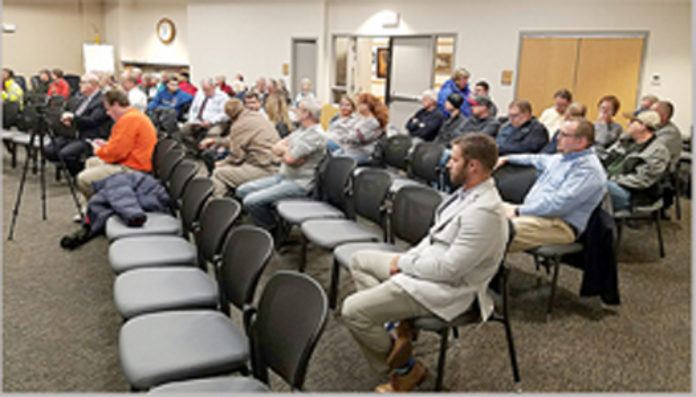While Wayne Township would contribute something each year to the Warsaw-Wayne Township Fire Territory fire station No. 3, it can’t contribute $100,000 annually as indicated at prior Warsaw City Council meetings.
And if the township can’t contribute, and provide a memorandum of understanding to the city how it would contribute, there will not be a third fire station, according to Mayor Joe Thallemer.
The estimated cost of the fire station is $3.7 million, with the general obligation bonds not to exceed $3.9 million. The fire station is planned for the northwest corner of County Farm Road at CR 200S on property purchased from Warsaw Community Church in 2011.
The council held its second reading and public hearing on two bond ordinances for the new fire station Monday night. During the nearly three-hour meeting, questions arose about how money could be saved on the building through alternative bids and the township’s contribution. The ordinances were tabled until the Dec. 5 meeting.
Rob Bishop, Wayne Township Advisory Board president, told the council, “The township has been a partner with the city for a number of years. As many of you probably know, Wayne Township actually provides the ambulance service that runs in the city and that costs — used to cost — almost $500,000. With Scott’s (Sigerfoos) help, we’re down to $240,000 now.”
Bishop noted Thallemer has asked the township to help pay for the bond.
“We are more than happy to do so,” Bishop said. “Unfortunately, our nice Umbaugh (& Associates) representative has told us that we are extraordinarily limited in what we can do to help out.”
Through the EMS contract, he said, the township is in a great cash position, so initially Wayne Township voted Sunday night, subject to the memorandum, to make a down payment of $250,000 toward the fire station. How that will occur will be part of the memorandum.
“It was proposed that the township pay $100,000 per year. Probably not feasible, Bishop said. “Our whole budget now is about $600,000. Umbaugh can tell you we can’t levy for the money. We can’t budget for the money, (Department of Local Government Finance) won’t approve it. So if we have money left at the end of the year, we can transfer it to the fire territory, is our understanding, and we are more than willing to do that every year that it is possible to do it.”
He said the memorandum wasn’t completed as of last night. He said he hoped the council saw that the $250,000 down payment showed that it was committed to fire station No. 3.
Thallemer asked Bishop when he anticipates the memorandum being completed. Bishop said it shouldn’t take more than a couple of days.
Councilman Ron Shoemaker asked if the township couldn’t commit to $100,000 a year. Bishop said they’ve never been able to do that but that was a recommendation from Umbaugh.
Councilwoman Cindy Dobbins asked the mayor if the $100,000 they were expecting from the township built into the tax rate for the bond.
“The tax rate for the bond covers the entire bond. And the annual payments that we anticipate from the township we hope to cover as we move on. But the $250,000 — I haven’t seen the MOU yet, so that obviously needs to be a part of this. But the MOU has the attachment showing the expectation for the township. The township can’t pledge that amount,”Thallemer said.
Todd Samuelson, with Umbaugh & Associates, explained that Umbaugh wasn’t making the rules, just helping to interpret them.
“The DLGF, the way the statute is written, does not allow the township to a.) issue bonds for the project or b.) increase its levy to make a payment towards it. So the payment the township will be making based on the agreement will have to come from its existing levy. There’s some room there. And the $100,000 is not what we recommended necessarily … but we used a methodology to represent what that payment would be if it’s based on assessed value in terms of what the assessed valuation is of the total territory and how much assessed value lies in unincorporated Wayne Township,” Samuelson said.
If the city bonds for about $3.7 million, the annual payment over 15 years will be around $300,000, so the breakdown of the assessed valuation is about one-third for the township and two-thirds for the city, he said. Any payment the township made would be made the year before the bond payment was due. If the township didn’t make any payment, the city would have to pay the balance that was due, which could be up to the annual $300,000 payment.
“That $300,000 is still less than what the city is currently paying on its debt service, so there would be a reduction in the debt service, but in reality what is in the agreement is the township agreeing to make a payment each year toward the debt service. That debt service payment from the township would be in hand by June 30,” Samuelson said.
The memorandum is an agreement, he said, so if that agreement is not fulfilled, there are consequences. The consequences would be up to the city and the fire territory.
A few minutes later, Thallemer indicated, “If we don’t have an MOU, we’re not selling bonds. That’s as simple as that, and I’ve communicated that. If we don’t have an MOU, we won’t sell bonds.”
Earlier in the meeting, Thallemer asked Jack Daniel, with the architectural firm MartinRiley, about eliminating certain spaces to save money. Earlier this year, Thallemer reminded the council, plans for the building were reduced from having three equipment bays to two.
Daniel said three options for alternates came to mind: taking the step out of the roof that the third-story window is in and bring that down to a single plane; eliminating the basement, though it’s the least expensive square footage; and reducing the square footage on the second level.
The council asked Daniel to have figures on those options available at the 7 p.m. Dec. 5 meeting.
Fire Chief Mike Wilson said all the equipment for the third station has been purchased since the fire territory was formed in 2009. Nine new firefighters may be hired for the third station — with two already hired — but the fire territory is evaluating other options, like part-time firefighters.





